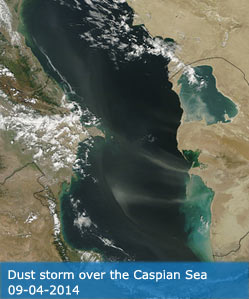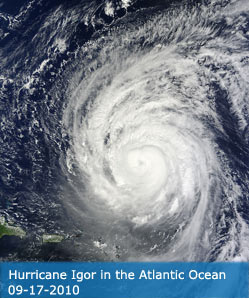Images
February 26, 2020 - Tropical Cyclone Esther
Tweet
Tropical Cyclone Esther was making landfall over Australia’s Northern Territory on February 24, 2020, when the Moderate Resolution Imaging Spectroradiometer (MODIS) on board NASA’s Aqua satellite acquired a true-color image of the stormy scene. At that time, Esther showed strong bands of thunderstorms wrapping into a low-level center as it impacted the Northern Territory.
Esther formed in the Gulf of Carpentaria on February 23 at 10 a.m. EST (1500 UTC) as a tropical storm, and was designated Tropical Cyclone 19P. At 4:00 p.m. EST (2100 UTC), 19P was renamed Esther and triggered warnings as it neared the southeastern coast of the Northern Territory. Early on February 24, Esther passed over the Pellew Islands and made landfall near Borrololla.
On February 24 at 4:00 a.m. EST (0900 UTC), the Joint Typhoon Warning Center (JTWC) issued their final warning on Esther. At that time, had maximum sustained winds near 58 mph (93 km/h). At that time, it was located near 16.7 degrees south latitude and 137.0 degrees east longitude about 454 nautical miles southeast of Darwin, Australia. Esther was moving to the west.
On February 25, Ex-Tropical Cyclone Esther continued across the Northern Territory on a westward path carrying heavy rain and wind squalls. At 7 a.m. EST (9:30 p.m. CST Australia local time) on that date, the Australian Bureau of Meteorology (ABM) noted that Ex-Tropical Cyclone Esther was located about 90 kilometers (55 miles) northeast of Elliott, moving west northwest. The system was expected to continue moving west through the northern Barkly District or southern Carpentaria District overnight and move into the eastern parts of the Gregory District on Wednesday morning as a deep tropical low. Squally thunderstorms and heavy rainfall are likely, particularly close to the system center.
Image Facts
Satellite:
Aqua
Date Acquired: 2/24/2020
Resolutions:
1km (285.4 KB), 500m (1 MB), 250m (2.4 MB)
Bands Used: 1,4,3
Image Credit:
MODIS Land Rapid Response Team, NASA GSFC
Tweet
Tropical Cyclone Esther was making landfall over Australia’s Northern Territory on February 24, 2020, when the Moderate Resolution Imaging Spectroradiometer (MODIS) on board NASA’s Aqua satellite acquired a true-color image of the stormy scene. At that time, Esther showed strong bands of thunderstorms wrapping into a low-level center as it impacted the Northern Territory.
Esther formed in the Gulf of Carpentaria on February 23 at 10 a.m. EST (1500 UTC) as a tropical storm, and was designated Tropical Cyclone 19P. At 4:00 p.m. EST (2100 UTC), 19P was renamed Esther and triggered warnings as it neared the southeastern coast of the Northern Territory. Early on February 24, Esther passed over the Pellew Islands and made landfall near Borrololla.
On February 24 at 4:00 a.m. EST (0900 UTC), the Joint Typhoon Warning Center (JTWC) issued their final warning on Esther. At that time, had maximum sustained winds near 58 mph (93 km/h). At that time, it was located near 16.7 degrees south latitude and 137.0 degrees east longitude about 454 nautical miles southeast of Darwin, Australia. Esther was moving to the west.
On February 25, Ex-Tropical Cyclone Esther continued across the Northern Territory on a westward path carrying heavy rain and wind squalls. At 7 a.m. EST (9:30 p.m. CST Australia local time) on that date, the Australian Bureau of Meteorology (ABM) noted that Ex-Tropical Cyclone Esther was located about 90 kilometers (55 miles) northeast of Elliott, moving west northwest. The system was expected to continue moving west through the northern Barkly District or southern Carpentaria District overnight and move into the eastern parts of the Gregory District on Wednesday morning as a deep tropical low. Squally thunderstorms and heavy rainfall are likely, particularly close to the system center.
Image Facts
Satellite:
Aqua
Date Acquired: 2/24/2020
Resolutions:
1km (285.4 KB), 500m (1 MB), 250m (2.4 MB)
Bands Used: 1,4,3
Image Credit:
MODIS Land Rapid Response Team, NASA GSFC




